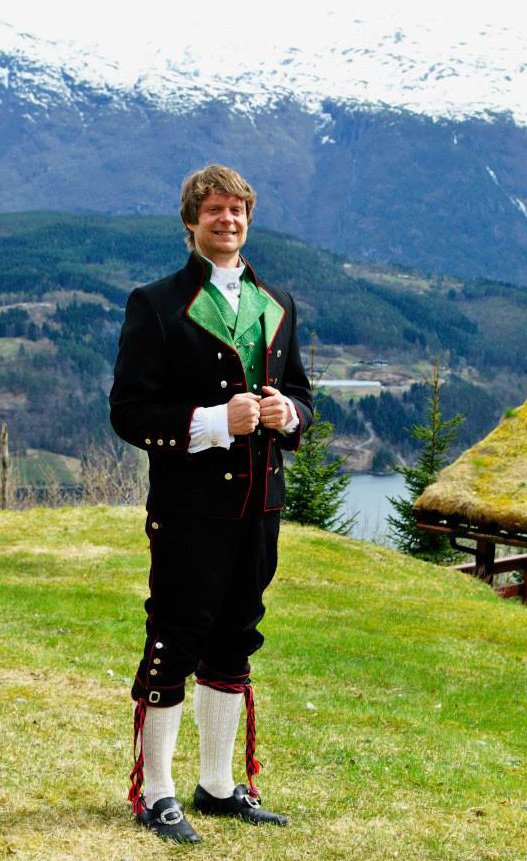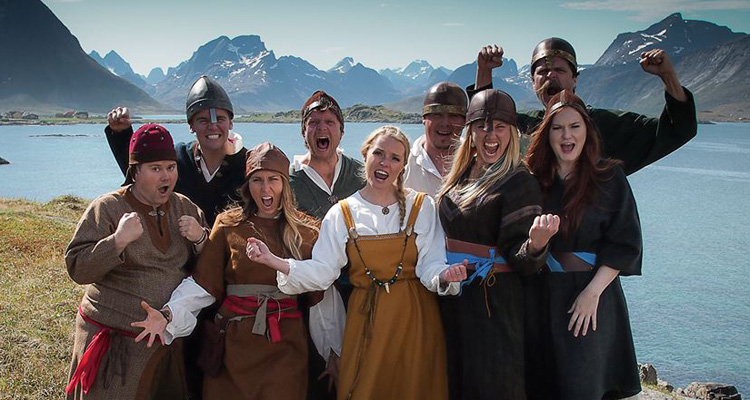In the late 19th century, Anders Hegreberg, 23, said goodbye to his family and the island, Vestre Amoy, off the coast of Stavanger, Norway, that his family had called home for centuries. His eyes set on a better life and a plot of land to call his own, he sailed across the Atlantic for America. He hunkered down in Iowa, then in a sod home of his own construction in Minot, North Dakota, before settling on a farm in Spicer, Minnesota, changing his first name to Andrew and starting a family.

Andrew "Anders" Hegreberg (seated) and his wife, Anna - Larsen's great-grandparents. Anders emigrated to the United States in 1892. This photo comes from a Hegreberg family history book, courtesy of Larsen.
Hegreberg never was able to return to Norway or see his family again. But in spring 2013 his great-grandson Greg Larsen ’93 made the journey back, albeit with a different itinerary and purpose.
Larsen, then 43, embarked on his maiden voyage to Norway with 11 fellow cast members and the film crew, including host Henriette Bruusgaard, of “Alt for Norge,” a hit Norwegian reality television show that takes 12 Norwegian-Americans on a journey across Norway where they compete in extreme cultural challenges. The winner receives a grand prize of $50,000 and, more significantly, a reunion with his/her Norwegian relatives.
Though his trip lasted only a little more than six weeks – he was sent home in episode seven (of 10) – Larsen believes the show set him on a lifetime journey thanks to the program’s unique format, which facilitates immersion in Norwegian culture and familial bonding amongst its cast members, and most meaningfully, provides previously unknown information about long-lost relatives.
Larsen's season aired fall 2013, but curiosity about his journey, his first to Norway, still abounds. As recently as last fall Larsen, who resides in Los Angeles, spoke about his experience to a crowd in Duluth, the area in which his dad was born and raised. He talked to the Newsroom earlier this year on life as a reality show contestant and what he learned about his heritage from his experience.
Landing a spot on 'Alt for Norge'
With Norwegians-Americans totaling around 5 million – roughly the population itself of Norway – merely having Norwegian ancestry is not going to get a person on the show (the only casting requirement is that interested folks have traceable Norwegian roots). Hopeful cast members need to stand out.

Larsen wears a traditional Norwegian bunad from his ancestors' region of Rennesoy (in Stavanger, Norway), during a taping of "Alt for Norge."
Larsen sent in audition tapes for seasons two and three, both times failing to capture the attention of producers. His third time proved to be the charm, though it coincided with "the worst possible time" for him and his family. "Even so, it likely had a lot to do with why I was selected," he surmised.
His mother, Renee Larsen, née Hegreberg, passed away in 2012. Soon after, members from her side of the family sold the family farm that Andrew had settled in Spicer.
“I spent every Christmas, Thanksgiving, Easter and the fourth weekend every June for the Hegreberg reunion on that farm, so my connection to my family history had just been stripped away on a couple different levels. It was crushing,” Larsen said. Amidst the upheaval, he and his wife, Sarah, and their two children had been looking for a house in Nashville by way of Los Angeles.
Larsen outshined around 2,000 first-round applicants and 60 semifinalists, who were flown to Chicago for interviews, to land his spot in season four. Every season has included at least one Minnesotan in the cast, often more.
Life as a reality show contestant
What is it like to compete in a reality show? Refreshingly for Larsen, there were no back-stabbing castmates, enflamed diatribes or covert alliances popularly associated with the genre.
“The whole purpose behind the show is what makes it a huge hit in Norway. It's the benevolence. We were all in it for the family reunion so we bonded instead of competing against each other in the traditional way of reality shows,” Larsen said in a Minnesota accent as thick as a slab of Norwegian brown cheese.
The show, which translates to “All for Norway,” the country’s royal motto, has contestants face a gauntlet of contests, obstacles and quizzes – all inspired by Norwegian culture – in various locations throughout the country.
In each episode, cast members compete on one of two teams, the losing team facing each other in an elimination round after which one teammate is immediately sent home. Larsen faced consecutive elimination rounds in the first three team challenges (episodes two through four); however, the series of misfortunes were ringed with an unexpected silver lining.
“It was extremely emotional and stressful to go into the rounds. You didn’t know what was coming next, and no one wanted to go home,” recalled Larsen, who survived all of the initial elimination rounds. “But these challenges led us through these transformative experiences. … It was like the most intense personal development workshop I’ve ever been a part of. It brought out the best in you and made you a better person because it tested you.”
Among the competitions and eliminations he survived were a simulated art heist of Edvard Munch's "The Scream" and a mock Viking raid on a village in the Lofoten Islands in which he had to steal "virgins," sacks of grain and sheep while angry "villagers" pelted him and his teammates with seaweed.
Ironically, Larsen, an aspiring country musician, was sent home by way of a challenge that should've been his specialty: singing. His downfall? His audience was a group of 5-year-old judges gathered at the Kristiansund Zoo and Amusement Park. Larsen was outperformed in his rendition of Kaptein Sabeltann's (in English, Captain Sabertooth, a fictional pirate and popular Norwegian children's character) famous theme song. He was no match for his two castmates, Liv Bly – a talented gymnast who executed feats of acrobatics – and Eric Hovland, a mustachioed Floridian whom Larsen described, like Bly, as a natural character possessing qualities that delight children. Having received only 18 percent of the tots' votes, Larsen was sent home, but not before he was made to walk the plank off Sabeltann's ship.

Cast members pose outside a gallery before participating in a mock art heist of Edvard Munch's famous painting "The Scream." Larsen is pictured on the far right.
A meaningful consolation prize
Larsen didn't walk away empty-handed, however. All of the contestants, win or lose, were given a hardcover book compiled by a team of genealogists hired by the show's producers that contained their Norwegian ancestral history and contact information for their long-lost living relatives.
Paging through the book with Bruusgaard, who presented it to Larsen after his elimination, Larsen was brought to tears.
"I think it's so important that everyone has a connection to where they're from," he told Bruusgard, choking up.
Now he not only had information on the great-great-grandfather, Truls Hegreberg, that he and his long-lost Norwegian family shared, but he also had his extended family's addresses and phone numbers. Larsen immediately sought to coordinate a face-to-face reunion, which came to fruition in November 2014 when he traveled back to Norway, this time to the Stavanger region of his ancestors.

Larsen's long-lost family tree, included in a family book compiled for Larsen courtesy of "Alt for Norge."
"Truls had six children, including Anders, with my great-great-grandmother, Maria. After she died, he remarried [a woman named Elen] with whom he had six more kids, and those are the family I got to meet when I went back," he said.
In his youth, Larsen admittedly took little interest in his heritage. His maternal grandmother had compiled a small history book of her lineage, so he knew the Hegrebergs hailed from an island in the Stavanger region. Her book told of how Truls cleared the land of rocks so the family, who were subsistence farmers, could plant what they were able on their one acre of land. How they fished blustery waters in rowboats for lobster, cod and salmon, taking what they needed and selling the rest at market.
Something the book didn't tell, which Larsen discovered at the reunion, was how he, and generations of his progenitors, could've been surnamed "Jacobson."
"I found out that Truls was born on the next island over, and his last name at birth was Jacobson," he said. "Some relatives owned the [Hegreberg] farm, but they didn't have any kids to pass it down to so Truls inherited it somehow and changed his name to Hegreberg, which in Norwegian means 'Heron Hill.' It was common practice at the time to name (or rename) oneself according to the land one owned."
As an added bonus, Larsen was able to stay on Truls' land, now owned by two of Truls and Elen's great-grandsons who welcomed him as their guest. Larsen also learned that the land on which the original Hegreberg barn and farmhouse had stood had been owned by the Norwegian government since shortly after the end of World War II when condemned after Nazi forces hollowed out part of Hegreberg and used it to store munitions during Germany's occupation of Norway during the war.
On his return to Norway, Larsen climbed to the top of Hegreberg near his ancestors’ homestead for his first time. From his perch, he realized the sacrifices that were made to start over in the U.S.
“Going back after the show was such a visceral experience,” he said. “There are petroglyphs on my family’s island that date back 3,000 years, so I saw that I go back several thousand years! My core was, in a sense, forged there.” Reconnecting with his heritage, he said has been a “stunning, life-changing” experience that he encourages others to seek.
Today Larsen is an author, musician and co-host – with his wife, Dr. Sarah Larsen – of "Miracle Makers," a podcast with a focus on personal development.







